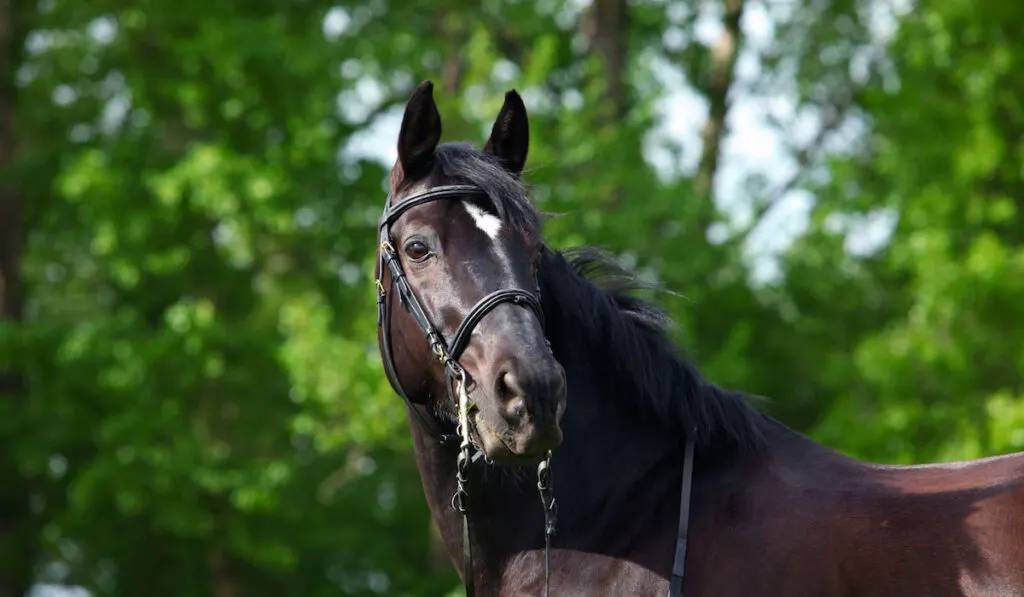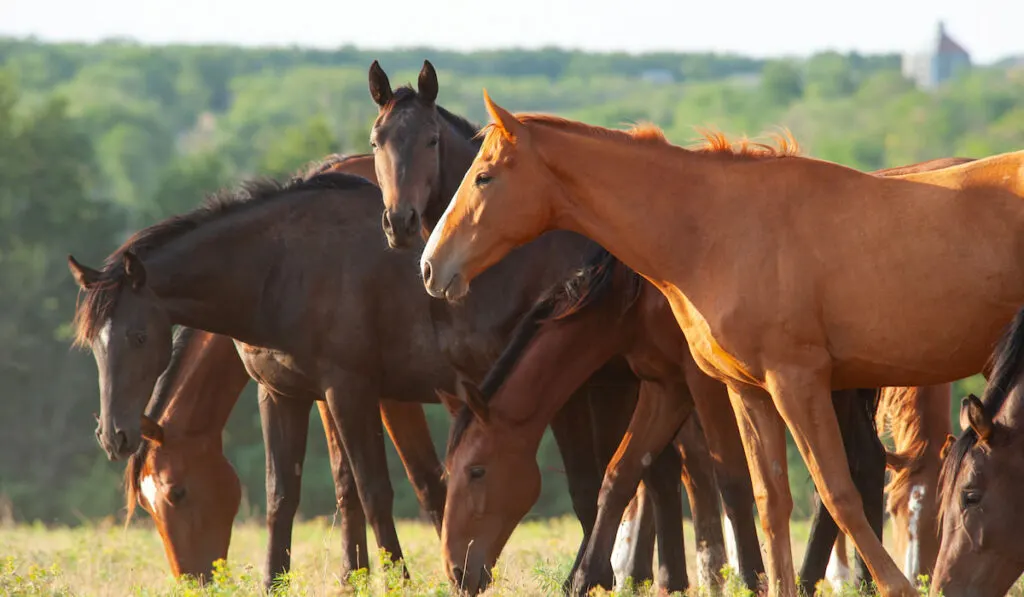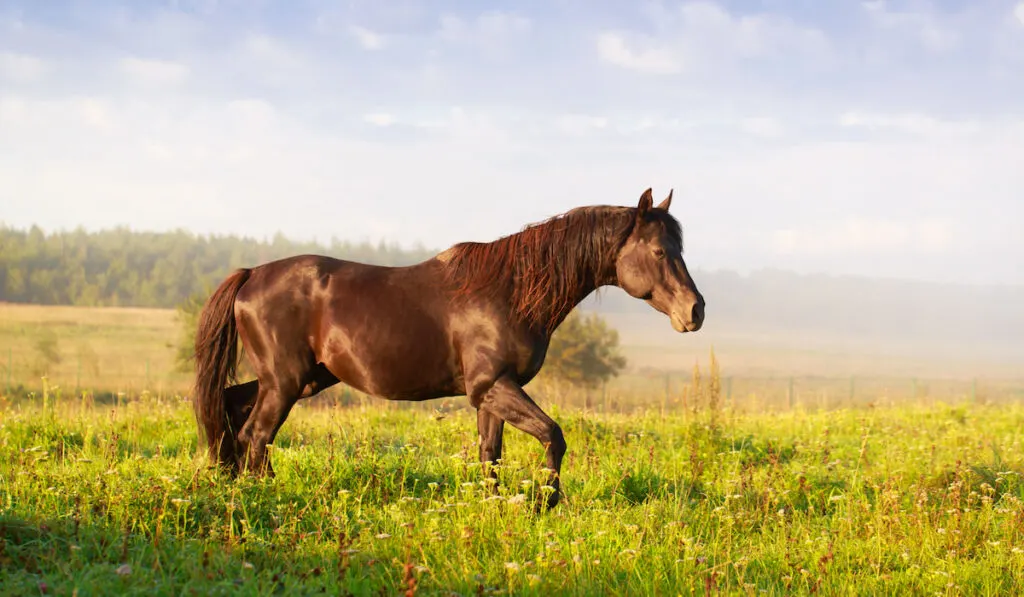Finding the right horse that suits your needs can be challenging. There are numerous horse breeds with different sizes, shapes, and temperaments.
Some breeds are strong and athletic but can be hard to handle. Meanwhile, calm and friendly breeds might possess different stamina and endurance than aggressive breeds.
But if you narrow your choices and dig deeper, you can have both calm and athletic horses. One such rare horse is the Trakehner horse breed.
If hearing their name has sparked your interest, we have outlined in-depth details of Trakehner horses and what makes them unique from other breeds.
That said, let’s get into it, shall we?

Table of Contents
The History of Trakehner Horse
Trakehner horses hailed from East Prussia, which is now known as Germany. They are the oldest warmblood horses that were created from a cross between Thoroughbred, Arabian, and Turkoman horses.
The Trakehner horse was first developed by King Friedrich Wilhem I in Trakehnen, East Prussia, in the early 18th century. He intended to create a better, faster, and stronger horses for his Prussian armies.
But King Friedrich didn’t want heavy horses to face any upcoming wars. Instead, he believed that speed could trump strength.
Moreover, weapons and armor have turned lighter than they used to. So, Prussian armies and officers didn’t need bulky or heavy breeds that couldn’t run fast.
King Friedrich also considered horses’ appearance and how they looked when people rode them. He wanted an elegant breed that looked attractive but could still perform effectively.
In 1732, he took seven of his best horses as foundations and created a new breed that could fulfill his requirements. And this is how the first batch of Trakehner horses came into existence.
Meanwhile, Prussian farmers also developed this breed in their farms and villages. They needed high-endurance horses that were capable of carrying loads and plowing fields.
Another theory stated that the first foundation stud to create the Trakehners was a horse named Schwaike. Schwaike possessed the physical prowess and stamina needed to develop a high-performance breed.
In 1787, a royal stud manager appointed by King Friedrich known as Count Karl Lindenau began to refine the Trakehners. He began filtering and allowing only the best stallions and mares in the herd.
From 1817 to 1837, Thoroughbreds and Arabians were brought into the gene pool to improve this breed. During World War I and II, more Trakheners were used in combat and military activities.
Unfortunately, thousands of horses were killed in these wars, leaving their population down to 100 horses.
So, breeders and war survivors took prudent action by searching for other surviving Trakehners to save this breed from extinction.
After the war, a group known as the Trakehner Verband was also established to protect and rebuild the Trakehner horses’ population.
In 1950, the German federal government contributed their effort to breeding more Trakehners horses.
During this period, these horses were also brought to the United States before the American Trakehner Association (ATA) creation in 1974.
As for Trakehner enthusiasts in the United Kingdom, they can refer to the Trakehner Breeders’ Fraternity for help and advice regarding this breed.

Appearance and Characteristics of Trakehner Horse
Trakehner horses are athletic equines with sturdy frames and muscular bodies. They have medium-sized heads with narrow muzzles, large eyes, sloping shoulders, and muscular necks.
Their strength and speed come from their solid hindquarters and forelimbs.
These horses also have different coat colors, such as black, gray, roan, bay, pinto, and chestnut.
On average, Trakehner horses stand 15 to 17 hands high and weigh 1,200 pounds.
Trakehner Horse Behavior and Temperament
Although some high-performance horses are aggressive and hard to handle, you won’t face all these issues with Trakehner horses.
Trakehner horses are generally well-tempered, intelligent, and obedient to their owners.
These horses are also hardworking, energetic, and eager to please. With their powerful stamina, there is no shortage of rigorous activities they can handle.
Diet and Feeding Habit
Trakehner horses are low-maintenance warmbloods.
Therefore, they don’t require a special feeding regime besides common pasture and hay.
Incorporating fiber-rich foods into your Trakehner horse’s diet is also beneficial to their health. You can feed these horses with high-quality pellets for extra minerals or nutrients.
Trakhner horses are also known as easy keepers. Easy-keeper breeds don’t require a high-calorie diet like any other large breeds.
So, be sure to monitor their diet to prevent overfeeding and obesity. You can also take them for a run to keep them active.
The best way to have a balanced lifestyle for the Trakehners is always by finding a sweet spot between a proper diet and regular exercise.

Health Issues and Lifespan
Trakehner horses are generally healthy. With proper care and diet, they can live up to 25 years.
Since they descend from the Arabians, it is still possible for these horses to inherit some of the genetic diseases that commonly occur in their descendants.
For instance, Trakehner foals may suffer from cerebellar abiotrophy that causes degeneration of neuron cells in the cerebellum.
Signs of cerebellar abiotrophy in affected foals are loss of balance, head tremors, wider stance, and unusual gaits.
So far, there is no cure for this neurological disease. Signs of cerebellar abiotrophy also appear in affected foals before they reach six months old.
Other diseases that can affect foals of this breed are lavender foal syndrome and severed combined immunodeficiency. Affected foals with lavender foal syndrome are born with a lavender or pale pink coat color.
They also exhibit symptoms such as lack of balance, inability to stand, seizures, involuntary eye movement, and limb hypertension.
Unfortunately, most Trakhener foals with lavender foal syndrome die immediately after birth.
Meanwhile, severed combined immunodeficiency causes a weakened immune system in foals.
As a result, infections and other severe health issues can quickly happen in their bodies.
Signs of severed combined immunodeficiency are weight loss, diarrhea, pneumonia, impaired growth, and lameness. Affected foals usually die within six months after birth.

Trakehner Horse Uses
Since there are no wars today and heavy farm work is replaced by tractors and other technologies, Trakehner horses can shine in their own way.
They are primarily used in competition, racing, dressage, show jumping, and other equestrian events.
In fact, many Trakehners rose to fame when they won an established competition. For instance:
- Abdullah – Conrad Homfeld rode this stallion in show jumping and eventing. Abdullah won numerous awards from the American Trakehner Association and gained a silver medal in 1986 for the United States at the Show Jumping World Championship in Germany.
- Windfall – Windfall was foaled in 1992. Timothy Holekamp bought and imported this stallion to the United States in January 2001. Windfall performed in many dressage and jumping shows with a successful eventing record from 2001 until 2007.
- Biotop – Biotop was a legend and champion in the Grand Prix dressage. Famously ridden by Dr Reiner Klimke, this Russian-bred stallion passed away at 27 years old in Germany.
- Downlands Cancara – Downlands Cancara was a superstar. This stallion appeared in many commercial advertisements and television, representing Llyond Banks numerous times for adverts in 1988. Cancara also attended press calls, fashion shows, and many charities in Britain.
- Heuriger – Heuriger was crowned as the world’s most successful dressage stallion. Ellen Bontje rode this stallion and obtained a silver medal at the 1994 World Equestrian Games.
Final Thoughts
Although Trakehner horses are well-tempered and easy to handle, they aren’t fit for beginners and children.
So, if you intend to make them family horses, ask for professional advice.
Over time, with enough training and care, having Trakehner horses around can open you to many possibilities and activities that other common breeds don’t have.
Who knows, you can finally enter a competition with your most prized horse? The sky is the limit.
Resources
- http://americantrakehner.com/trakehners/History.asp
- http://trakehners-international.com/history/index.html
- https://www.trakehners.uk.com/
- https://ker.com/equinews/warmbloods-feeding-plan-horses/
- https://www.thesprucepets.com/trakehner-horse-full-profile-history-and-care-5080185
- https://ceh.vetmed.ucdavis.edu/health-topics/cerebellar-abiotrophy-ca
- https://ceh.vetmed.ucdavis.edu/health-topics/lavender-foal-syndrome-lfs
- https://ceh.vetmed.ucdavis.edu/health-topics/severe-combined-immunodeficiency-scid
- https://en.wikipedia.org/wiki/Abdullah_(horse)
- https://www.eurodressage.com/2012/04/15/biotop-passed-away
- https://en.wikipedia.org/wiki/Windfall_II
- https://en.wikipedia.org/wiki/Downlands_Cancara
- https://www.horsemagazine.com/thm/2022/09/the-trakehners-strike-back-part-2/

